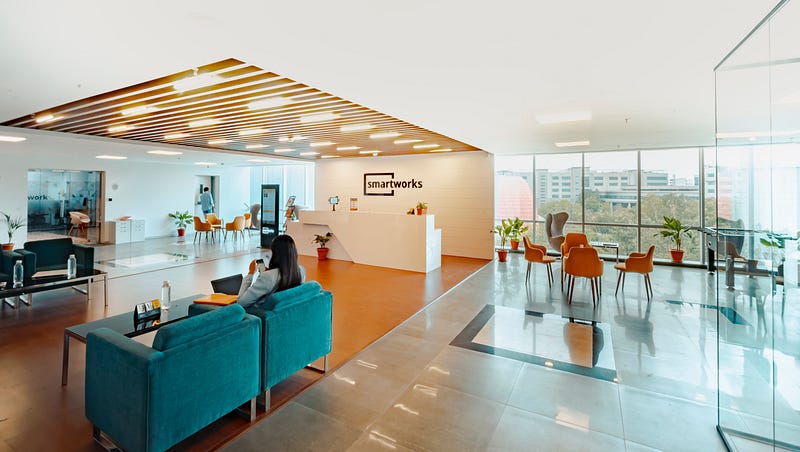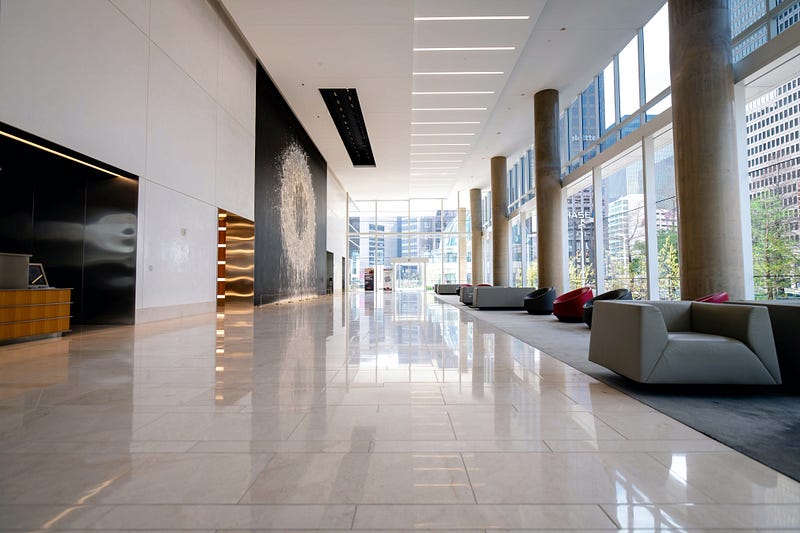The Sericescape
The ‘servicescape’ has become a little-discussed marketing topic in the digital age; yet has quite a considerable influence on customers if you are a service business with a physical location.
First, the servicescape forms a perception in the mind of customers. Then, it contributes to their service experience.
“Physical environments, also termed servicescapes, play an important role, both positive and negative, in customers’ impression formation (Bitner, 1992).”
Welcome to week eighteen of 50 weeks of marketing. This week, we will explore the servicescape and how services can provide a better experience for customers.
 |
| The servicecape of a modern office |
What is the servicescape?
The servicescape is the physical environment where a service transaction takes place. It facilitates the customers’ experience, but it also influences their first impressions before they even enter the store or interact with a staff member. This first impression helps customers ease any discomfort of the unknown, then guides their perception and expectations of the service.
In a service encounter, customers interact with the service continuously. For example, at a restaurant. You might have numerous interactions with staff and use the restroom. Service providers need to create a pleasant, convenient, and satisfying experience for customers.
“The design of the physical environment and service staff qualities that characterise the context which houses the service encounter, which elicits internal reactions from customers leading to the display of approach or avoidance behaviours.” (Bitner, 1992)
Bitner (1992) introduced the term servicescape to define the context for a service encounter. It is the physical setting where customers consume a service and/or product and the company and customer interacts with each other. Businesses can (and should) modify their servicescape to match customer expectations and influence customer perceptions. This perception will engage customers to act in a certain way.
If it does not expect and is negatively perceived, chances are the customer will not come back. So, there is a relationship the servicescape and customer loyalty. It is something businesses need to get right. Investing in your servicescape can improve customer relationships and facilitate more sales.
Other definitions for the servicescape has included:
“The physical environment”, “atmospherics”, “marketing environment”, “economic environment”, “interactive theatre”, “healthscapes”, “environmental psychology”, “servicescape”, “store environment”, “service environment”, and “social-servicescape” (Harris & Ezeh, 2008)
Characteristics of a servicescape
The physical aspects of the service environment are organisationally controllable, objective and measurable. This includes the exterior and the interior of the “brick and mortar” physical environment and the ambience of the service encounter, such as background music and cleanliness, the overall design and furnishings, and the staff’s competence and presentation. The physical components of a servicescape include:
Exterior
• Landscape
• Exterior design
• Surrounding environment
• Parking
• Signage
Facility Interior
• Music
• Layout
• Equipment
• Air quality temperature
• Interior design
Others
• Virtual servicescape
• Web pages
• Employee uniforms
• Stationary
• Business cards
These make up three dimensions of environmental stimuli according to Bitner’s original framework: ambient conditions, spatial layout and functionality and signs, symbols, and artefacts.
There is now a fourth element identified as contributing to the experience: the social dimension.
 |
| Ambience or atmosphere adds to the experience at cafes |
Ambient conditions
The ambience of a business can be the deciding factor of whether or not a customer comes back. Especially in a café, bar or restaurant. The customer wants to feel as relaxed and as comfortable as possible. If it is too hot, or too cold for example, this will not help the customer enjoy their experience.
The ambience was too often overlooked by services, but as we have moved from a product-based to a service-based economy, it is a common expectation from customers to have a certain level of ambience. Aspects such as colour, music, noise, smell and lighting all contribute to the ambience of an environment. These affect our senses and influence our experience.
Ambience fills most Cafés. Background music and the noise of people talking, the scent of coffee beans, big bright menu displays. This provides a pleasant service encounter for the customer.
Compare going to your favourite café to sitting in a quiet empty room drinking a coffee alone.
“Ambient conditions represent background environmental stimuli, or atmospherics that affect human sensations. These stimuli comprise visual (e.g. lighting, colours, brightness, shapes, aesthetic cleanliness, olfactory (scent, air quality, fragrance) ambient (e.g. temperature) and auditory (e.g. music, noises) elements.” (Rosenbaum & Massiah, 2011)
Spatial layout and functionality
The physical attributes of a store should be the starting point for businesses as they can observe and measure how effectively the layout and functionality enhance employee and customer activity. It is objective and controllable.
Spatial layout refers to the arrangement of furnishings and equipment, their design and what they look like, and the general spatial relationship between these objects in the store. Consider comfort, layout, and accessibility as this can influence consumer approach or avoidance decision-making. Will they turn around and walk back out?
Functionality is the extent to which the business can facilitate the service and provide customer support. This will be dependent on how much help the customers require.
 |
| Hotel lobbies and office buildings need functional layouts and style |
Signs, Symbols and artefacts
The signage of a business is the first and most obvious places to communicate with customers at your place of business. A big sign in the exterior of the building to communicate your brand to people driving past and signage in the interior of your store. As well as your branding, signs can communicate how to behave in store such as where the toilets are, where to pay, where in-store certain items are.
Symbols and artefacts help contribute to the vibe and atmosphere of a servicescape. Examples of this are the artwork on the wall, and décor design — is it themed or inspired by another culture? People usually interpret these similarly, as the store design will have a certain symbolic meaning and purpose. However, an individual’s ethnicity, for example, can be a moderator for how they perceive a servicescape dependent on how authentic it is to their expectation. This can influence a consumer’s response.
“Bagozzi (1975) noted that most marketplace exchanges are mixed exchanges, in which consumers fulfil not only their utilitarian needs but also their social and psychological needs. Thus, customer approach/avoidance decisions are influenced not only by physical stimuli but also by social, humanistic stimuli.” (Rosenbaum & Massiah, 2011)
The social dimension
The social aspect of a service encounter is dependent on the staff and the environment creating a positive consumption experience for customers. Components of this include the placement of customers, their involvement and interaction with employees. How much are customers able to contribute to the feeling of the atmosphere?
Service providers can be an outlet to remedy loneliness, through consumption communities. Often locally owned and independent, owners and employees at these businesses ‘know’ all about the neighbourhood and the people living there, and often have several ‘regulars’ — customers often spend time there as a home away from home. It becomes a community where people have a sense of belonging and can engage in social encounters free from any constraints and judgement based on their socio-economic status for example.
People subconsciously seek connections with ‘the rest of life, which Wilson (1984) called biophilia. Commercial services such as local bars can encourage these natural encounters, providing value to customers on a personal, psychological level. Oldenburg (1999) called these “third places”.
These service experiences can be restorative to consumers and enhance their wellbeing, through feelings of ‘being away’ and ‘compatibility’. Being away does not require distance but gives people a feeling of ‘escape’, beyond the realms of home and work Temporarily, the experience exports people to a different place. Natural settings are popular destinations for restoration, such as the topical beaches, botanical gardens, and mountain ranges.
“The sense of being away does not require distance; however, it does require that a person feel as though he or she is momentarily in another world.” (Rosenbaum & Massiah, 2011)
 |
| The outdoor servicescape |
The roles of the servicescape
If your business has a physical store, your servicescape plays four key roles in the success of your business. I will separate these into two categories: Facilitation and socialising, and brand image and differentiation.
Facilitation is keeping the purchasing and service delivery process as convenient and efficient as possible, whilst socialising facilitates interactions between both customers and employees and between the customers themselves. Brand image is the impression customers get from your servicescape and differentiation set your business apart from your competitors.
“The physical environment influences sales, time spent in the store, perceptions of the service experience, satisfaction, dissatisfaction, product choice and customer retention. The physical elements directly influence purchasing behaviour and as such can either aid or hinder a service organisation from achieving its marketing goals.” (Tombs, McColl-Kennedy, 2003)
Facilitation and socialising
The design and fit-out of a service help facilitate two main goals: first to be as efficient as possible to maximise how productive staff are at their job, and also ensuring the customer has the experience they want. Ineffective designs can be frustrating to staff and customers alike. The design of the servicescape can also illustrate to customers where they can and cannot go.
We do not want to hinder the performance of staff or their enjoyment of their jobs, and equally, we do not want to focus on maximising the performance of staff if that reduces the quality customer experience. In services such as restaurants or cafés, the servicescape design helps both customers and employees socialise, to help facilitate a pleasurable experience with friends, family or business clients.
Overcrowding in retail stores in shopping centres can hurt atmospherics. However, in some contexts such as live sport and concerts, crowding is positive for consumers as it adds to peoples’ enjoyment. Social contagion spreads the happiness or ‘atmosphere’ throughout the crowd. Cafes, bars and nightclubs can have a similar feeling, where part of the attraction is because people like to socialise.
The ideal social density changes between service encounters, and because it affects the customer experiences and their intent for future consumption, it is something business owners need to understand. Find out whether a social experience is important to your consumers and create a spatial layout that facilitates greater social interaction. Other business customers might want to avoid each other as much as possible, such as a bank, doctor or solicitor.
Brand image and differentiation
The servicescape for a business is much like the packaging for a product or a website. It conveys a certain expectation to customers, and they perceive it in their unique way. It will attract some people and others will not like it. One person will feel comfortable in a place and not so much in another.
Such Hell’s Pizza here in New Zealand. The took a slice of the pizza market away from Pizza Hut and Dominoes with their unique branding. Your servicescape helps differentiate your brand from the next. For example, McDonald’s versus Burger King. The food is remarkably similar, but the restaurants are vastly different and there is no way you would confuse the two. The unique ‘Golden Arches’ at McDonald’s as you drive in the first dead giveaway, then there’s Ronald McDonald and the playgrounds…
All of this creates an image in the mind of consumers of what to expect. It helps position your brand in the market to attract your target customers. The playgrounds at McDonald’s targeted at families and unashamedly so. Your servicescape communicates your unique value proposition for customers and it will help attract attention to your business.
That is week eighteen of 50 weeks of marketing! I hope you enjoyed this week’s content about Servicescape.
See you next week,
Dan

No comments:
Post a Comment